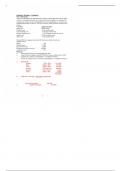2Question 1 (20 marks 36 m inutes) –
Part A (10 marks) Atkinson Technologies has determined that a sing le overhead application rate no longer results in a reasonable allocation of overhead to its diverse products. Accordingly, the company has restructured its overhead a pplication. It has established six cost pools and identified appropriate cost drivers. The new cost pools, allocation bases, and rates are as follows: Cost Pool Application Ra te
Setup costs $70 per setup Machine costs 30 per machine hour Labour-related costs 15 per direct labour hour Material handling costs 2 per kilogram of material received Quality costs 150 per customer return Other costs 8 per machine hour During 2006, the company experienced the following volume for each cost application base: Setups 300 Machine hours 9,000 Direct labour hours 8,000 Kilograms of material received 100,000 Customer returns 250 Required: a. Determine the amount of overhead applied in 2006. b. Assume that the company incurred $740,000 in actual overhead costs in 200 6. Compute the company’s underapplied or overapplied overhead. a. Applied OH: Setups 300 $ = ×70 $ 21,000 MHs 9,000 $30 = ,000 × 270 DLHs 8,000 $ = ,000 ×15 120 #s rec'd 100,000 $2 = 200,000 × Returns $ = 250 ×150 37,500 Other 9,000 $8 = ,000 × 72 $720,5 00 b. $( 00) $720,500 - $740,000 = 19,5 underapplie d Cost of Goods Sold $19,500 c. Applied Overhead $19,500 3Question 1 Part B (10 m arks) Newmarket Cosmetic Hospital is under increa sing pressure for the charges it assesses its patients. Except for an explicit consideration of direct costs for surgery, medication, and other treatments, the current pricing system is an ad hoc one based on pricing norms for the geographical area. As the hospital controller, you have suggested that pricing would be less arbitrary if there were a tighter relationship between costs and patient charg es. As a first step, you have determined that most costs can be assigned to one of the following three cost pools. Cost Pool Amount Activity Driver Quantity Professional salaries $1,100,000 Professional hours 40,000 hours Building costs 500,000 Square metres used 20,000 square metres Risk management 400,000 Patients served 2,000 patients Hospital services are classified into three broad categories. The services and their volume measures follow. Service Professional Hours Square Metres Number of Patients Surgery 6,000 1,200 200 Inpatient care 20,000 12,000 500 Outpatient care 4,000 1,800 300 Required: a. Determine the allocation rate for each cost pool. b. locate costs among the three hospital services using the allocation rates derived Al
in part (a). a. Professional salaries: $1,100,000 40,000 = $27.50 per hour Building costs: $500,000 ,000 = $ per square metre 20 25 Risk management: $400,000 2,000 = 00 per patient $2 b. 25 $2 Surgery = (6,000 X $27.50) + (1,200 X $ ) + (200 x $200) = 35,000 Inpatient care = (20,000 x $27.50) + (12,000 x $ ) + (500 x $ 0) = 25 20
$950,000 Outpatient Care = (4,000 x $27.50) + (1,800 x $ ) + (300 x $200) = 25
$215,000 c. $1,100,000 + $500,000 + $ 400,000 = $2,000,,000 patients = $1000 / patient. - Advant ages: simple to apply, low cost, makes intuitive sense, - Disadvant ages: complicated to apply, expenses, inaccurate




